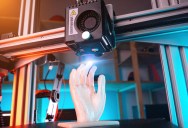3D Printing Is Helping To Heal Major Skin Wounds And Could Revolutionize Head And Face Reconstruction

It’s impossible to wrap our minds around the scale and scope of scientific research that is going on all day, every day.
For every problem humans have there is a scientists somewhere trying to figure out how to leverage technology to fix it.
Now, medical researchers have 3D-printed human skin and placed it over significant wounds on a rat.
The team is out of Penn State and they’re hoping their work will lead to significant improvements in reconstructive surgery and hair treatments in humans.

Professor Ibrahim Ozbolat was the lead author on the ensuing paper.
“Reconstructive surgery to correct trauma to the face or head from injury or disease is usually imperfect, resulting in scarring or permanent hair loss.”
There have been previous successes with bioprinted layers of skin, and the team out of Penn State built on those, claiming to have seamlessly repaired damaged skin tissue by printing the bottom and middle layers of the skin.
When you replace the hypodermis and middle dermis, the epidermis (top layer) heals itself over time.
“With this work, we demonstrate bioprinted, full thickness skin with the potential to grow hair in rats. That’s a step closer to being able to achieve more natural-looking and aesthetically pleasing head and face reconstruction in humans.”
Their bioink is made of a network of proteins and stem cells and a clotting solution to bind everything together. The proteins and stem cells are extracted from human fat tissue.
“We printed directly into the injury site with the target of forming the hypodermis, which helps with the wound healing, hair follicle generation, temperature regulation, and more.”

It only took two weeks for the epidermis to form on top of the 3D printed sub-layers – hair follicles included.
“We believe this could be applied in dermatology, hair transplants, and plastic and reconstructive surgeries – it could result in a far more aesthetic outcome.”
They have been awarded a patient for their bioprinting technique, but there is still work to do to prove it will work on human models.
Only time – and some human test subjects – will tell whether or not this technique will revolutionize reconstructive surgery going forward.
If you thought that was interesting, you might like to read a story that reveals Earth’s priciest precious metal isn’t gold or platinum and costs over $10,000 an ounce!

Sign up to get our BEST stories of the week straight to your inbox.




